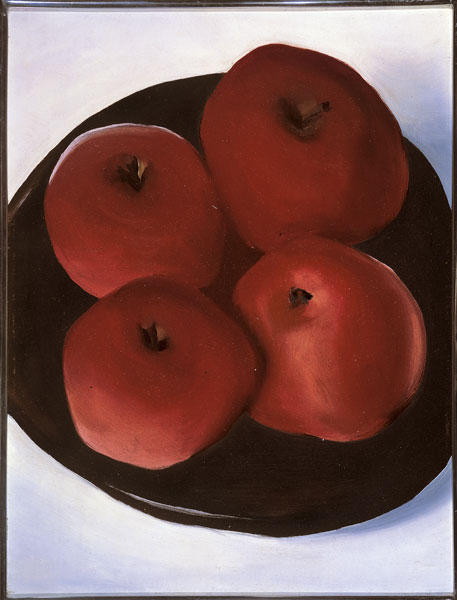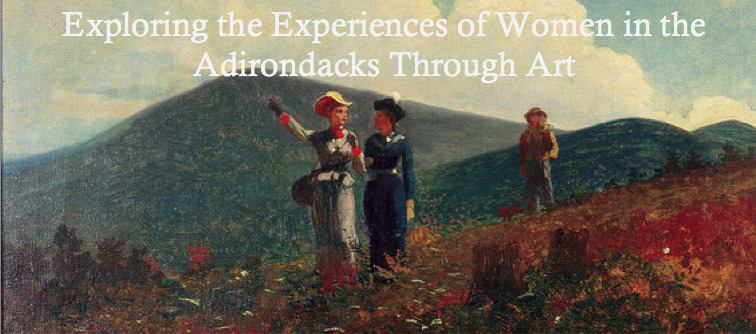
Those who are familiar with Georgia O’Keeffe know that she was madly in love with, and spent the majority of her time in, New Mexico. She is generally considered an artist of the desert, but it is lesser known that she also had a fling with the Adirondacks, and specifically Lake George. Her Adirondack work uniquely combines serenity with the sublime colors of the region. Though she produced many famous works, this page focuses solely on the works she produced during her time in the Adirondacks.

 It is widely acknowledged that Lake George played a role in facilitating a breakthrough in Georgia O’Keeffe’s artwork. O’Keeffe cared deeply for the land, though never much for the historical significance of the area. Interestingly, O’Keeffe does not include any evidence of man’s imprint on nature in her paintings (Coe, 43). At times O’Keeffe expressed in writings that Lake George was perfect and beautiful, but other times she felt it oppressively lush, overripe and suffocating (Coe, 66). Perhaps, for O’Keeffe, the characteristics that made Lake George generally accepted as desirable and beautiful, were to her its downfall (Coe, 67).
It is widely acknowledged that Lake George played a role in facilitating a breakthrough in Georgia O’Keeffe’s artwork. O’Keeffe cared deeply for the land, though never much for the historical significance of the area. Interestingly, O’Keeffe does not include any evidence of man’s imprint on nature in her paintings (Coe, 43). At times O’Keeffe expressed in writings that Lake George was perfect and beautiful, but other times she felt it oppressively lush, overripe and suffocating (Coe, 66). Perhaps, for O’Keeffe, the characteristics that made Lake George generally accepted as desirable and beautiful, were to her its downfall (Coe, 67).
Georgia O’Keeffe first visited the Adirondacks as a young artist 1908 when she was 21 on a class trip from the Art Students League (Coe, 25). Her second trip was in 1918 with Alfred Stieglitz to his family’s 36-acre estate that served as a rural retreat (Coe, 26). For the next ten years of her life O’Keeffe spent her winters and springs in New York City, and her summers and falls in Lake George (Coe, 26). During her time in Lake George, the natural aspects of the area, especially the flowers, inspired O’Keeffe.


Initially, O’Keeffe was enamored with red canna lilies. During her time in the Adirondacks in 1918 she painted a series of seven watercolors that focused on a single canna lily stem (Coe, 27). The theme of the canna lily reoccurred in 1919 and 1920, with 20 canna lily printings ensuing, and all cumulating with the fiery Red Canna (right) (Coe, 27). In the summer of 1924 she planted beds of purple petunias, providing the impetus for her first enlarged flower painting (Coe, 50). These paintings of flowers were a “prelude to the botanical works long considered her most original contribution the twentieth–century art”, and were the works that garnered the most attention from critics in NYC who perceived them as erotic and sexual (Coe, 50). Finally, O’Keeffe took a special interest in poppies during her time in Lake George. Fields of poppies bloomed on the Stieglitz property, and in the mid-twenties O’Keeffe had produced 6 paintings of poppies, cumulating with the Red Poppy (left) in 1928 (Coe, 57).
But flowers weren’t O'Keeffe's only inspiration dring her stays in Lake George. O’Keeffe also loved to paint Adirondack trees, using them to add scale and drama to her paintings (Robertson, 84). She also loved leaves, especially in the fall (Coe, 63). Fall was her favorite season, because of the vivid colors that were visiable in the mountains (Coe, 43). O’Keeffe also included paintings of apples and corn in her collection (Coe, 59,61).

Although not natural, O’Keeffe also spent some time focusing her work on the barns. Barns were a subject she knew well from her childhood growing up in Wisconsin, and she eventually did a total of 14 paintings of barns in Lake George (Coe, 48,47). These paintings have been interpreted as expressions of her feelings of confinement and isolation while staying with the Stieglitz family in the Adirondacks (Coe, 48).

From her writings, it appears that O’Keeffe enjoyed her time in Lake George more in her younger years than her later years. Whether or not she enjoyed the social aspect, or even the copious amounts of green, her time in Lake George certainly had an impact on her later works.
Our classmates Eliza Geeslin and Ally Kontra also discuss O'Keeffe on their website.
Take a look:http://courses.hamilton.edu/adirondack-art/outsider-artists/georgia-okeeffe
